
Therapsida is a clade comprising a major group of eupelycosaurian synapsids that includes mammals and their ancestors and close relatives. Many of the traits today seen as unique to mammals had their origin within early therapsids, including limbs that were oriented more underneath the body, resulting in a more "standing" quadrupedal posture, as opposed to the lower sprawling posture of many reptiles and amphibians.

Eucynodontia is a clade of cynodont therapsids including mammals and most non-mammalian cynodonts. The oldest eucynodonts are known from the Early Triassic and possibly Late Permian. Eucynodontia includes two major subgroups, Cynognathia and Probainognathia.
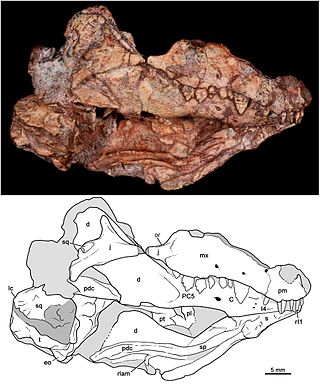
Probainognathidae is an extinct family of insectivorous cynodonts which lived in what is now South America during the Middle to Late Triassic. The family was established by Alfred Romer in 1973 and includes two genera, Probainognathus from the Chañares Formation of Argentina and Bonacynodon from the Dinodontosaurus Assemblage Zone of Brazil. Probainognathids were closely related to the clade Prozostrodontia, which includes mammals and their close relatives.

Probainognathus meaning “progressive jaw” is an extinct genus of cynodonts that lived around 235 to 221.5 million years ago, during the Late Triassic in what is now Argentina. Together with the genus Bonacynodon from Brazil, Probainognathus forms the family Probainognathidae. Probainognathus was a relatively small, carnivorous or insectivorous cynodont. Like all cynodonts, it was a relative of mammals, and it possessed several mammal-like features. Like some other cynodonts, Probainognathus had a double jaw joint, which not only included the quadrate and articular bones like in more basal synapsids, but also the squamosal and surangular bones. A joint between the dentary and squamosal bones, as seen in modern mammals, was however absent in Probainognathus.
Lepagia is an extinct genus of poorly known carnivorous cynodonts, which lived during the Upper Triassic in Europe. Partly due to the paucity of remains the precise affinities of this genus are unclear. It seems reasonably closely related to Probainognathus, a somewhat earlier inhabitant of South America. The genus Lepagia was named by Hahn, Wild and Wouters in 1987 based on a single species.
"Hahnia" obliqua is a poorly known species of meat-eating stem-mammals (cynodonts) that lived during the Upper Triassic in Europe. It is based on tiny, isolated teeth, and its affinities with other cynodonts are unclear. The generic name is not valid, thus the quotation marks. The name Hahnia has already been used for a spider. The authors are aware of this, and will doubtless come up with a new name sometime in the future.
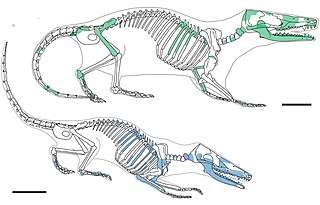
Docodonta is an order of extinct Mesozoic mammaliaforms. They were among the most common mammaliaforms of their time, persisting from the Middle Jurassic to the Early Cretaceous across the continent of Laurasia. They are distinguished from other early mammaliaforms by their relatively complex molar teeth. Docodont teeth have been described as "pseudotribosphenic": a cusp on the inner half of the upper molar grinds into a basin on the front half of the lower molar, like a mortar-and-pestle. This is a case of convergent evolution with the tribosphenic teeth of therian mammals. There is much uncertainty for how docodont teeth developed from their simpler ancestors. Their closest relatives may have been certain Triassic "symmetrodonts", namely Woutersia, and Delsatia. The shuotheriids, another group of Jurassic mammaliaforms, also shared some dental characteristics with docodonts. One study has suggested that shuotheriids are closely related to docodonts, though others consider shuotheriids to be true mammals, perhaps related to monotremes.
Tritylodontidae is an extinct family of small to medium-sized, highly specialized mammal-like cynodonts, with several mammalian traits including erect limbs, endothermy and details of the skeleton. They were the last-known family of the non-mammaliaform synapsids, persisting into the Early Cretaceous.
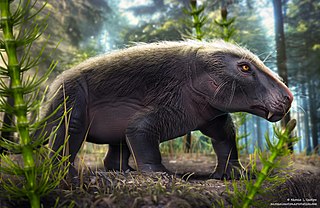
Traversodontidae is an extinct family of herbivorous cynodonts. Traversodonts were primarily Gondwanan, with many species known from Africa and South America. Recently, traversodonts have also been found from Europe and North America. Traversodonts first appeared in the Middle Triassic and diversified in the Late Triassic before going extinct at the end of the epoch. The family Traversodontidae was erected by Friedrich von Huene in 1936 for cynodonts first found in São Pedro do Sul in Paleorrota, Brazil.
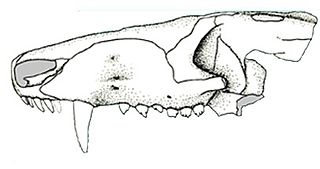
Prozostrodon is an extinct genus of probainognathian cynodonts that was closely related to mammals. The remains were found in Brazil and are dated to the Carnian age of the Late Triassic. The holotype has an estimated skull length of 6.7 centimetres (2.6 in), indicating that the whole animal may have been the size of a cat. The teeth were typical of advanced cynodonts, and the animal was probably a carnivore hunting reptiles and other small prey.
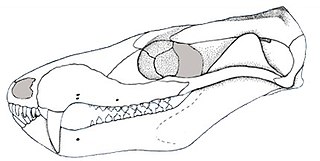
Brasilodon is an extinct genus of small, mammal-like cynodonts that lived in what is now Brazil during the Norian age of the Late Triassic epoch, about 225.42 million years ago. While no complete skeletons have been found, the length of Brasilodon has been estimated at 12 centimetres (4.7 in). Its dentition shows that it was most likely an insectivore. The genus is monotypic, containing only the species B. quadrangularis. Brasilodon belongs to the family Brasilodontidae, whose members were some of the closest relatives of mammals, the only cynodonts alive today. Two other brasilodontid genera, Brasilitherium and Minicynodon, are now considered to be junior synonyms of Brasilodon.
Mitredon is an extinct genus of cynodonts which existed in the Fleming Fjord Formation of Greenland during the Rhaetian age of the Late Triassic epoch. The type and only species is Mitredon cromptoni.
Rosieria is an extinct genus of dwarf cynodonts from the Late Triassic of France. It belongs to the family Traversodontidae, a herbivorous group known mainly from Gondwana. The type species R. delsatei was named in 1997 on the basis of a few isolated postcanine teeth found in Saint-Nicolas-de-Port in northeastern France. These teeth were found alongside the teeth of many other cynodonts, including those of Hahnia, Gaumia, and Maubeugia. The small size of the teeth in Saint-Nicolas-de-Port suggest R. delsatei and other species were dwarf cynodonts. Most teeth in the locality belong to insectivores like dromatheriids, while those of R. delsatei and other herbivorous cynodonts are very rare.

Alemoatherium is an extinct genus of prozostrodontian cynodont which lived in the Late Triassic of Brazil. It contains a single species, A. huebneri, named in 2017 by Agustín Martinelli and colleagues. The genus is based on UFSM 11579b, a left lower jaw (dentary) found in the Alemoa Member of the Santa Maria Formation, preserving the late Carnian-age Hyperodapedon Assemblage Zone. Alemoatherium was among the smallest species of cynodonts found in the rich synapsid fauna of the Santa Maria Formation. Its blade-like four-cusped postcanine teeth show many similarities with those of dromatheriids, an obscure group of early prozostrodontians.
Polonodon is an extinct genus of dromatheriid cynodonts that lived in what is now Poland during the Carnian stage of the Late Triassic. It includes one species, Polonodon woznikiensis, which is known only from isolated teeth.

Pseudotherium is an extinct genus of prozostrodontian cynodonts from the Late Triassic of Argentina. It contains one species, P. argentinus, which was first described in 2019 from remains found in the La Peña Member of the Ischigualasto Formation in the Ischigualasto-Villa Unión Basin.

Bonacynodon is an extinct genus of cynodonts that lived in what is now southern Brazil during the Triassic period. The genus is monotypic, containing only the type species Bonacynodon schultzi. B. schultzi is known from two specimens, consisting of two partial skulls and some badly preserved parts of the postcranium. Both specimens were recovered from the Pinheiros-Chiniquá Sequence, part of the Santa Maria Supersequence of the Paraná Basin. This sequence preserves a faunal association known as the Dinodontosaurus Assemblage Zone, which contains numerous other species of cynodonts, dicynodonts and reptiles. Bonacynodon was a small, likely insectivorous cynodont, whose length has been estimated at around 30 centimetres (12 in). It can be distinguished from other cynodonts by its large, serrated (saw-like) canine teeth. Together with the genus Probainognathus of Argentina, it made up the family Probainognathidae, one of the earliest-diverging lineages of the clade Probainognathia. It was a fairly close relative of mammals, the only group of cynodonts alive today.
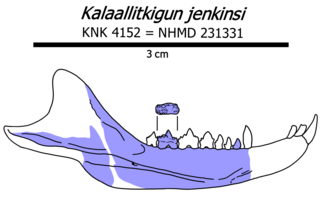
Kalaallitkigun is an extinct genus of haramiyidan mammaliaforms from the Late Triassic of Greenland. It contains a single species, Kalaallitkigun jenkinsi, which was described in 2020 from a partial dentary found in the Fleming Fjord Formation. More specifically, it was found in the mid-late Norian Carlsberg Fjord beds of the Ørsted Dal Member. It is the oldest of several mammaliaform species discovered in the Late Triassic sediments of Greenland. It is also the oldest mammaliaform with double-rooted teeth, and its pattern of tooth cusps help to clarify the evolution of haramiyidan teeth relative to their morganucodont-like ancestors.
Inditherium is an extinct genus of dromatheriid cynodonts that lived in what is now India during the Late Triassic. Its type and only species is Inditherium floris, which is known from three postcanine teeth discovered at the Tiki Formation of Madhya Pradesh.

Santacruzgnathus is an extinct genus of small cynodonts from the Late Triassic (Carnian) Santacruzodon Assemblage Zone of Brazil. It contains one species, S. abdalai. Santacruzgnathus is known from a single partial lower jaw with four postcanine teeth, only one of which is well-preserved. Some features of the specimen, including the slender shape of the jaw and the incipiently double-rooted teeth, indicate that the animal was an early member of Prozostrodontia, a group that includes mammals and their close relatives.

















